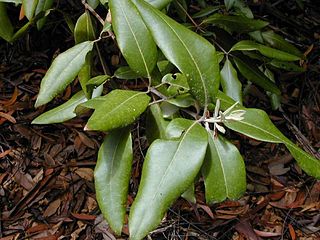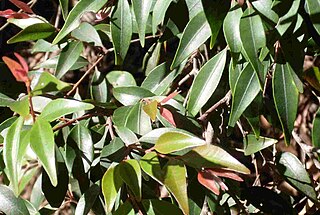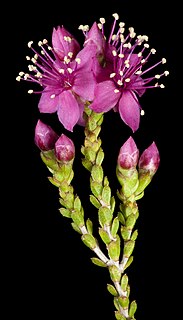
Myrtaceae or the myrtle family is a family of dicotyledonous plants placed within the order Myrtales. Myrtle, pōhutukawa, bay rum tree, clove, guava, acca (feijoa), allspice, and eucalyptus are some notable members of this group. All species are woody, contain essential oils, and have flower parts in multiples of four or five. The leaves are evergreen, alternate to mostly opposite, simple, and usually entire. The flowers have a base number of five petals, though in several genera the petals are minute or absent. The stamens are usually very conspicuous, brightly coloured and numerous.

Syncarpia is a small group of trees in the myrtle family (Myrtaceae) described as a genus in 1839. They are native to Queensland and New South Wales in Australia.

Uromyrtus is a genus of plants in the myrtle family Myrtaceae described as a genus in 1941. The greatest diversity of species are found in New Caledonia and the remainder are found in Australia, New Guinea and Borneo.
Chamguava is a genus of the botanical family Myrtaceae, first described as a genus in 1991. It is native to southern Mexico and Central America.
- Chamguava gentlei(Lundell) Landrum - Chiapas, Belize, Guatemala, Honduras
- Chamguava musarum(Standl. & Steyerm.) Landrum - Guatemala
- Chamguava schippii(Standl.) Landrum - Guerrero, Chiapas, Belize, Guatemala, Panama

Temu cruckshanksii is a species of plant in the family Myrtaceae. It is endemic to Chile. It is threatened by habitat loss. The purported variety "Heaven Scent" sold commercially is likely just the unimproved plant.

Blepharocalyx is a genus of plant in family Myrtaceae first described as a genus in 1854. It is native to South America and the West Indies.
- Blepharocalyx cruckshanksii(Hook. & Arn.) Nied. - Chile
- Blepharocalyx eggersii(Kiaerskou) L.R.Landrum - Lesser Antilles, Venezuela, Guyana, Peru, Brazil
- Blepharocalyx myriophyllus Mattos - Minas Gerais
- Blepharocalyx salicifolius(Kunth.) O.Berg - Brazil, Bolivia, Peru, Ecuador, Paraguay, Uruguay, N Argentina
Neomitranthes is a genus of plant in family Myrtaceae first described as a genus in 1977. The entire genus is endemic to Brazil.

Rhodomyrtus is a group of shrubs and trees in the family Myrtaceae described as a genus in 1841. The genus is native to southern China, the Indian Subcontinent, Southeast Asia, Melanesia, and Australia.
Myrteola is a plant genus in the Myrtaceae described as a genus in 1856. It is native to South America and the Falkland Islands.

Rhodamnia is a group of rainforest trees and shrubs in the myrtle family described as a genus in 1822. They are native to southern China, Southeast Asia, Papuasia, Australia, and New Caledonia.
Barongia is a genus of flowering plants in the myrtle family, Myrtaceae first described as a genus in 1988. It contains only one known species, Barongia lophandra, endemic to the Cook region of Queensland, Australia.

Homalocalyx is a genus of shrubs in the family Myrtaceae described as a genus in 1857. The entire genus is endemic to Australia.
Homalospermum is a genus of plants in the myrtle family first described as a genus in 1843. It contains only one known species, Homalospermum firmum, endemic to the southwestern part of the State of Western Australia.
Kjellbergiodendron is a genus of the botanical family Myrtaceae, first described as a genus in 1936. It contains only one known species, Kjellbergiodendron celebicum, endemic to the Island of Sulawesi in Indonesia.
Myrtella is a genus of plants in the Myrtaceae described as a genus in 1877. It is native to New Guinea and to some islands of the western Pacific.
- Myrtella beccariiF.Muell. - New Guinea, Solomon Islands
- Myrtella bennigseniana(Volkens) Diels - New Guinea, Caroline Islands, Mariana Islands

Neomyrtus is a genus of plants in the family Myrtaceae described in 1941. It contains only one known species, Neomyrtus pedunculata, endemic to New Zealand. It is found there on both the North Island and the South Island.
Purpureostemon is a genus of plant in the myrtle family Myrtaceae described as a genus in 1939. There is only one known species, Purpureostemon ciliatus, endemic to New Caledonia. Purpureostemon is related to Xanthostemon.

Siphoneugena is a genus of the botanical family Myrtaceae, first described as a genus in 1856. It is native to Central and South America as well as the West Indies.
Whiteodendron is a genus of plant in family Myrtaceae described as a genus in 1952. It contains only one known species, Whiteodendron moultonianum, endemic to Borneo.

Myrteae is the largest tribe in the plant family Myrtaceae. It includes most of the species of the family that have fleshy fruits.









